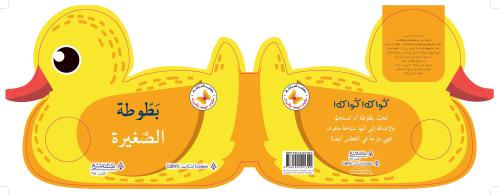AVAILABLE IN ARABIC
About This Book
Dealing with student misbehavior and encouraging student motivation are two of the most important concerns for new teachers. Classroom Management for Elementary Teachers, Ninth Edition, provides new and experienced teachers with the skills, approaches, and strategies necessary to establish effective management systems in the elementary-school classroom.
Based on 30 years of research and experience in more than 500 classrooms, the newest edition of this best-selling text presents step-by-step guidelines for planning, implementing, and developing classroom management tasks to build a smoothly running classroom that encourages learning. Students can apply what they learn as they review and complete the examples, checklists, case study vignettes, and group activities presented in each chapter.
Topics : Teaching Strategies,Classroom Management
Table Of Content
Chapter 1: Organizing Your Classroom and Supplies
Four Keys to Good Room Arrangement
Suggestions for Arranging Your Classroom
Wall and Ceiling Space
Floor Space
Storage Space and Supplies
Further Reading
Suggested Activities
Checklist 1: Room Preparation
Chapter 2: Establishing Classroom Rules and Procedures
What Is an Effectively Managed Classroom?
Preliminary Considerations
Definition of Terms
Identifying School Rules and Procedures
Planning Classroom Rules
Student Participation in Rule Setting
Planning Classroom Procedures
Procedures for Room Use
Procedures for Individual Work and Teacher-Led Activities
Transitions into and out of the Room
Procedures for Small-Group Instruction
General Procedures
Further Reading
Suggested Activities
Case Study 2.1: Classroom Rules and Procedures in a Second-Grade Class
Case Study 2.2: Using Centers in a Multitask Classroom
Checklist 2: Classroom Rules and Procedures
Chapter 3: Procedures for Managing Student Work
Clear Communication of Assignments and Work Requirements
Instructions for Assignments
Standards for Form, Neatness, and Due Dates
Procedures for Absent Students
Monitoring Progress on and Completion of Assignments
Monitoring Work in Progress
Monitoring the Completion of Assignments
Maintaining Records of Student Work
Managing Student Portfolios
Managing the Paperwork
Feedback to Students
Further Reading
Suggested Activities
Case Study 3.1: Managing Student Work
Case Study 3.2: Keeping Students Involved During Center Activities
Case Study 3.3: Using Technology in an Upper Elementary Grade
Case Study 3.4: Poor Work and Study Habits in a Fourth-Grade Class
Checklist 3: Student Work Accountability Procedures
Chapter 4: Getting Off to a Good Start
Creating a Positive Climate in Your Classroom
Teaching Rules and Procedures
Teacher Authority
Planning for a Good Beginning
Planning for the First Days of School
Some Typical Activities
Communicating with Parents and Guardians
Special Problems
Preparing for a Substitute
Further Reading
Suggested Activities
Case Study 4.1: Beginning the Year in a Literature-Based Primary Classroom
Case Study 4.2: Beginning the Year in a Sixth-Grade Math Class Using Cooperative Learning
Checklist 4: Preparation for the Beginning of School
Chapter 5: Planning and Conducting Instruction
Planning Instructional Activities
Types of Planning
Types of Instructional Activities
Arranging Activities within a Lesson
Planning for Clear Instruction
Technology in the Classroom
Kounin's Concepts for Managing Whole-Group Instruction
Preventing Misbehavior
Managing Movement
Maintaining Group Focus
Common Problems in Conducting Instruction
Transitions
Clarity
Further Reading
Suggested Activities
Problem 5.1:
Problem 5.2:
Problem g.3:
Case Study 5.1: Unclear Procedures
Case Study 5.2: A Science Lesson in a Sixth-Grade Class
Checklist 5: Planning for Instruction
Chapter 6: Managing Cooperative Learning Groups
Research on Cooperative Learning
Examples of Group Activities
Strategies and Routines That Support Cooperative Learning
Room Arrangement
Talk and Movement Procedures
Group Attention Signals
Promoting Interdependence within the Group
Individual Accountability
Monitoring Student Work and Behavior
Interventions for Groups
Effective Group Work Skills
Social Skills
Explaining Skills
Leadership Skills
Beginning the Use of Cooperative Learning Groups
Room Arrangement
Procedures and Routines
Forming Groups
Initial Group Tasks
Teaching Group Skills
Student Goals and Participation
Using Group and Individual Rewards
Further Reading
Suggested Activities
Checklist 6: Planning for Cooperative 8roup Instruction
Chapter 7: Maintaining Appropriate Student Behavior
Monitoring Student Behavior
Consistency
Management of Inappropriate Behavior
Building a Positive Climate
Improving Class Climate through Incentives and Rewards
Recognition
Activities
Symbols
Material Incentives
Caution in the Use of Rewards
Further Reading
Suggested Activities
Problem 7.1: Misbehavior in a Third-Grade Class
Chapter 8: Communication Skills for Teaching
Constructive Assertiveness
Stating the Problem or Concern
Body Language
Obtaining Appropriate Behavior
Empathic Responding
Listening Skills
Processing Skills
Problem Solving
Talking with Parents
Further Reading
Suggested Activities
Activity 8.1: Developing Assertiveness Skills
Activity 8.2: Recognizing Listening Responses
Activity 8.3: Producing Empathic Responses
Activity 8.4: Problem-Solving Exercises
Activity 8.5: Dialogue Analysis
Vignettes
Chapter 9: Managing Problem Behaviors
What Is Problem Behavior?
Nonproblem
Minor Problem
Major Problem but Limited in Scope and Effects
Escalating or Spreading Problem
Goals for Managing Problem Behavior
Management Strategies
Minor Interventions
Moderate Interventions
More Extensive Interventions
Special Problems
Bullying
Tattling
Chronic Avoidance of Work
Fighting
Power Struggles
A Final Reminder: Think and Act Positively
Further Reading
Suggested Activities
Chapter 10: Managing Special Groups
Assessing Entering Achievement
Identifying Special Groups
Strategies for Individual Differences
Team Teaching
Modifying Whole-Class Instruction
Supplementary Instruction
Individualized Instruction
Additional Strategies
Working with Students with Special Needs
Students with Learning Disabilities
Students with Emotional or Behavioral Problems
Students with Serious Social Deficits (Autism Spectrum Disorders)
Students with Attention Deficit and Hyperactivity
Students Who Are Deaf or Hearing Impaired
Students Who Have Visual Impairments
Students with Limited English Proficiency
Students Living in Extreme Poverty
Teaching Lower-Achieving Students
Active Instruction
Organizing and Pacing Instruction
Remedial Instruction
Building Positive Attitudes
Teaching Higher-Achieving Students
Further Reading
Suggested Activities
Case Study 10.1: Organizing Reading Instruction for Low-Academic-Level Students
Case Study 10.2: Supporting Students with Auditory Disabilities in the Classroom
Case Study 10.3: Teaching Students in a Third-Grade Inclusion Class
Problem 10.1: Team Teaching
Problem 10.2: A Heterogeneous Class
Appendix: Answer Keys for Chapter Activities
References and Further Readings
Index
About the Authors
Carolyn M. Everton:

CAROLYN M. EVERTSON, PH.D., Professor of Education Emerita, Peabody College, Vanderbilt University and Director of COMP, is one of the world's leading experts on classroom management. She and her colleagues conducted the original studies on how teachers manage classrooms from the first day of school.
These and subsequent studies led to over 120 articles, chapters and books on classroom management and supporting students' social and academic learning, including two textbooks, Classroom Management for Elementary Teachers and Classroom Management for Middle and High School Teachers (both with Edmund Emmer) published in their 9th editions. Along with Carol S. Weinstein, she edited the Handbook of Classroom Management: Research, Practice and Contemporary Issues (2006) Lawrence Erlbaum Associates.
Dr. Evertson received her Ph.D. in Educational Psychology and baccalaureate degree in Elementary Education from the University of Texas, Austin. While at Peabody College, Vanderbilt, she directed several federally funded projects on classroom teaching and teacher education. Carolyn developed COMP: Creating Conditions for Learning, to assist teachers in effective classroom management and instruction. COMP is validated by the National Diffusion Network and is included in the Comprehensive School Reform Demonstration Models, administered by Northwest Regional Laboratory for the Department of Education.
Edmund T.Emmer:
-
ISBN: 9789960860528
Author: Edmond T.Emmer, Carolyn M. Everton
Publisher: Educational Book House
Size: 17*24cm
Pages number: 394













